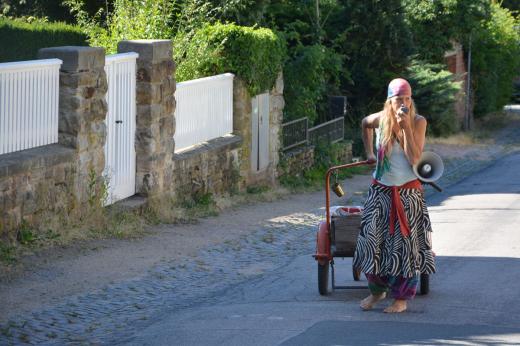Haderlumpen - Alte Sachen
Procedere
Dressed like a gipsy I draw a cart behind me and walk though the streets of Darmstadt in a wealthy area. I smash old pot lids to each other, so that they rattle loudly. Through a megaphone I am shouting: Alte Sachen! Alte Sachen! (old things).
People are looking curiously from the windows. Some bring old cloth. When I am standing for a longer time at one spot, more people are approaching. They also bring furniture, a sink, a hose trolley, cuddly toys. At once I offer the received goods to other people. Immediately, when I start to distribute them, people ask, why I am doing this and what is it all about.
When I speak in fractured German people stop asking too much about the purpose of my actions. With all the gathered goods I reach the center of international forest art. Here I continue to distribute the collected wares for free. Some of the objects, which do not find customers, I „plant“ in the soil together with my colleague Claudia Kappenberg.
Concept
Our society lives in abundance. I try to catch the inhabitants of a city directly at the site of their abundance, at their homes. So I collect “alte Sachen”(old things) in a wealthy area of the city. When I start to explain the idea of my work (as an artist), they pretend that they do not possess redundant things. If the goods are collected for charity, it is easier for them to give them away. So I approach them in the guise of a beggar.
I collect “useless things” from them and try to distribute them to their peers, to people, who are not needy, with the purpose of saving them from being discarded. It also means for me to save resources. It can reduce the amount of production of such as household items, clothing, furniture and toys, when people buy less and take what others don’t need any more.
Also to get well preserved things for free astonishes the people. Anonymos distribution like a flee market stall makes it easier to take them than directly from the previous owner.
Apparently, owning things is indeed associated with feelings of guilt in the presence of those in need, but the subjective feeling of owning is better than to be one of those, who does not possess. Almost all items find new owners.
In order not to leave anything unused, the remaining objects are transformed into an art installation.
Dressed like a gipsy I draw a cart behind me and walk though the streets of Darmstadt in a wealthy area. I smash old pot lids to each other, so that they rattle loudly. Through a megaphone I am shouting: Alte Sachen! Alte Sachen! (old things).
People are looking curiously from the windows. Some bring old cloth. When I am standing for a longer time at one spot, more people are approaching. They also bring furniture, a sink, a hose trolley, cuddly toys. At once I offer the received goods to other people. Immediately, when I start to distribute them, people ask, why I am doing this and what is it all about.
When I speak in fractured German people stop asking too much about the purpose of my actions. With all the gathered goods I reach the center of international forest art. Here I continue to distribute the collected wares for free. Some of the objects, which do not find customers, I „plant“ in the soil together with my colleague Claudia Kappenberg.
Concept
Our society lives in abundance. I try to catch the inhabitants of a city directly at the site of their abundance, at their homes. So I collect “alte Sachen”(old things) in a wealthy area of the city. When I start to explain the idea of my work (as an artist), they pretend that they do not possess redundant things. If the goods are collected for charity, it is easier for them to give them away. So I approach them in the guise of a beggar.
I collect “useless things” from them and try to distribute them to their peers, to people, who are not needy, with the purpose of saving them from being discarded. It also means for me to save resources. It can reduce the amount of production of such as household items, clothing, furniture and toys, when people buy less and take what others don’t need any more.
Also to get well preserved things for free astonishes the people. Anonymos distribution like a flee market stall makes it easier to take them than directly from the previous owner.
Apparently, owning things is indeed associated with feelings of guilt in the presence of those in need, but the subjective feeling of owning is better than to be one of those, who does not possess. Almost all items find new owners.
In order not to leave anything unused, the remaining objects are transformed into an art installation.
July 2015
Vogelfrei 11, Gartenutopien
Darmstadt
Equipment: a wheelbarrow, a megaphon, costume
Contributors: Claudia Kappenberg, Katharina Lökenhoff
Pics: Horst Bürkle, Thorsten Grosch,
Lutz Nevermann
Vogelfrei 11, Gartenutopien
Darmstadt
Equipment: a wheelbarrow, a megaphon, costume
Contributors: Claudia Kappenberg, Katharina Lökenhoff
Pics: Horst Bürkle, Thorsten Grosch,
Lutz Nevermann


























